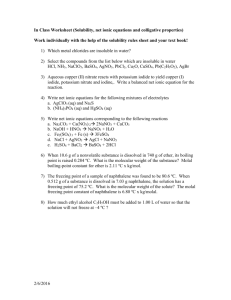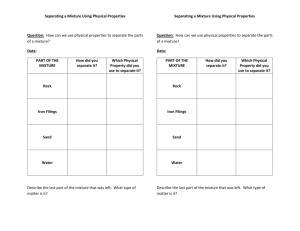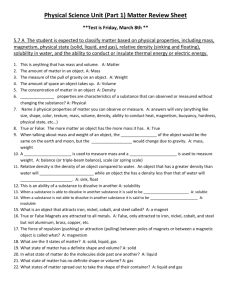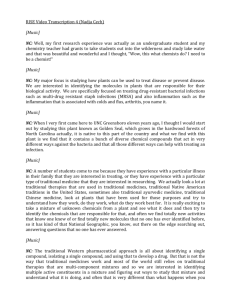Experiment #1: Determination of the Solid
advertisement
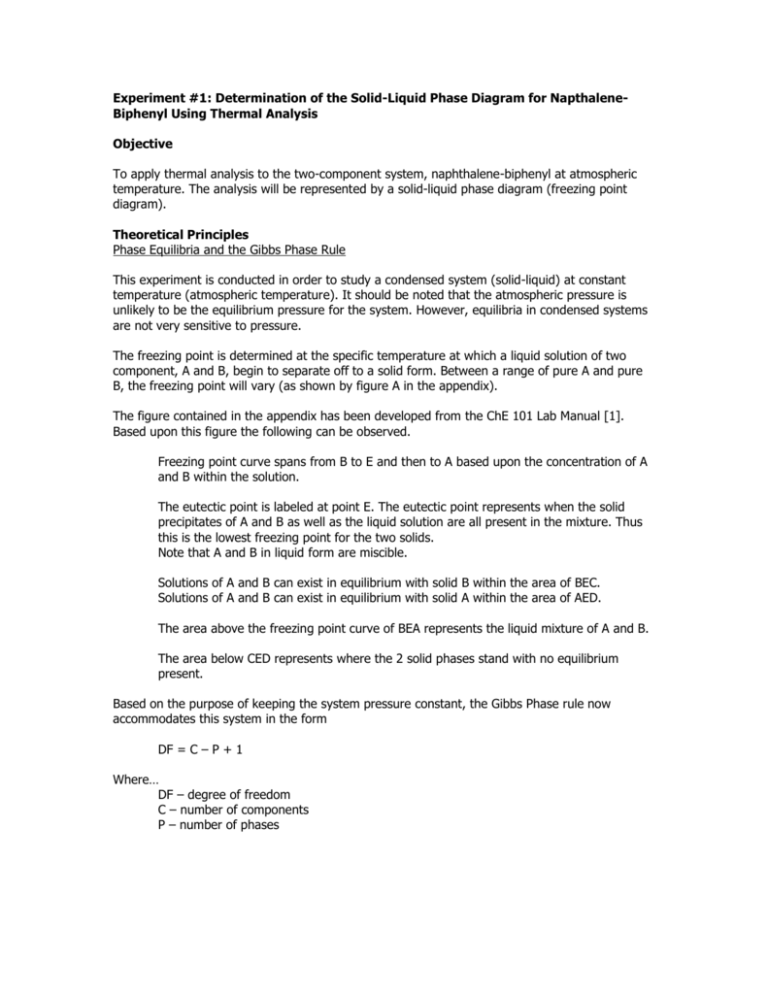
Experiment #1: Determination of the Solid-Liquid Phase Diagram for NapthaleneBiphenyl Using Thermal Analysis Objective To apply thermal analysis to the two-component system, naphthalene-biphenyl at atmospheric temperature. The analysis will be represented by a solid-liquid phase diagram (freezing point diagram). Theoretical Principles Phase Equilibria and the Gibbs Phase Rule This experiment is conducted in order to study a condensed system (solid-liquid) at constant temperature (atmospheric temperature). It should be noted that the atmospheric pressure is unlikely to be the equilibrium pressure for the system. However, equilibria in condensed systems are not very sensitive to pressure. The freezing point is determined at the specific temperature at which a liquid solution of two component, A and B, begin to separate off to a solid form. Between a range of pure A and pure B, the freezing point will vary (as shown by figure A in the appendix). The figure contained in the appendix has been developed from the ChE 101 Lab Manual [1]. Based upon this figure the following can be observed. Freezing point curve spans from B to E and then to A based upon the concentration of A and B within the solution. The eutectic point is labeled at point E. The eutectic point represents when the solid precipitates of A and B as well as the liquid solution are all present in the mixture. Thus this is the lowest freezing point for the two solids. Note that A and B in liquid form are miscible. Solutions of A and B can exist in equilibrium with solid B within the area of BEC. Solutions of A and B can exist in equilibrium with solid A within the area of AED. The area above the freezing point curve of BEA represents the liquid mixture of A and B. The area below CED represents where the 2 solid phases stand with no equilibrium present. Based on the purpose of keeping the system pressure constant, the Gibbs Phase rule now accommodates this system in the form DF = C – P + 1 Where… DF – degree of freedom C – number of components P – number of phases Thermal Analysis The basis of the phase diagram begins with recording a series of T vs. t plots at different A-B compositions. The thermal analysis of the T vs. t plot can be done in three sections. Change in slope – as the solution is cooled, precipitates start to form. The more precipitates forming causes a diminishing rate of cooling. A plateau or horizontal line can represent the precipitate of a eutectic solution or a pure solution. System continues to be cooled below the freezing point of both components at a diminished rate up until the eutectic point. From there the temperature is kept constant in order to solidify all the liquid portion remaining. Supercooling is a phenomena that can be represented by a temperature dip and then a sharp rise. Supercooling occurs when a liquid (still in its liquid state) is taken past its freezing point. Solidification occurs very suddenly. Lever Rule Since the melting points of naphthalene and biphenyl are dependent on their respective weight compositions, the lever rule can be used to find correlate specific points along the diagram. Though there will be a small degree of error due to human observation, the lever rule is a much faster alternative to methods involving mass balances. Apparatus Experimental Procedure Procedure is given by the ChE 101 Lab Manual [1]. 1. Experiments are divided into two groups. Group #1 will do test tube #1 (mixtures 1-4). Group #2 will do test tube #2 (mixtures 5-8). Tube #1 should contain 17g of naphthalene and tube #2 should contain 18g of biphenyl. Fit tube with thermocouple and stirrer and play in the melting bath until solids have melted. Allow tube and bath to reach equilibrium and record the melting temperature. 2. Set the controlled temperature bath to approximately 3oC below the melting temperature of the contents. Start stopwatch and start reading the temperature at 10 second intervals. 3. Obtain a cooling curve. Stir vigorously during cooling to prevent supercooling. The temperature of the cooling bath must be adjust so that it is always about 3oC below the temperature of the contents. 4. Remelt the contents of the tube and add the counterpart component based on the given schedule. Ask the demonstrator to adjust the cooling water between mixtures. During the experiment, record and plot the data obtained for all mixtures listed. The experiments are stopped as follows: i. Mixtures 1, 5, 8 – when plateau is reached ii. All others – when the initial change in slope can clearly be identified 5. Draw the SL diagram for naphthalene-biphenyl with ToC as the y-axis, and wt % as the x-axis. Results and Discussion Results Mixture 1 Refer to Figure 1: Mixture 1 By observation, the freezing point is determined to be 80.5oC. In comparison to the pre-lab data, Mixture 3 Refer to Figure 2: Mixture 3 It is suspected that the freezing point is 64.1oC. Due to the short temperature plateau, It is difficult to determine if the freezing point occurs at during the interval (6:00-6:10). However, it appears to be have been the most reasonable determination for freezing point in comparison to the rest of the plot. In comparison to the pre-lab data, Mixture 4 Refer to Figure 3: Mixture 4 By observation, the freezing point of this mixture is 51.6oC. In comparison to the pre-lab data, Mixture 5 Refer to Figure 4: Mixture 5 Due to the lengthy plateau, the freezing point is determined to be 69.1 oC. In comparison to the pre-lab data, Mixture 7 Refer to Figure 5: Mixture 7 Also due to a lengthy plateau, the freezing point is determined to be 45.1 oC In comparison to the pre-lab data, Mixture 8 Refer to Figure 6: Mixture 8 During this run, the mixture was unintentionally allowed to supercool. The supercooling took place for approximately 1 minute. With that in mind, the approximate freezing point is 38.8oC. In comparison to the pre-lab data, Errors Although somewhat negligible, the weight of biphenyl fluctuated between 18.00g and 18.06g when being measured by the balanced. Further possible errors could have been caused by the mishandling of the initial substances when being transferred to the test tubes. This would have lead to a lesser amount of naphthalene in mixtures 1, 3, and 4 as well as a lesser amount of biphenyl in mixtures 5, 7, and 8. As well, during the experiment, a small amount of the mixture would accumulate on the stirrer. Furthermore in regards to the stirrer, it did not reach the bottom of the test tube so it could be a possibility that the bottom of the mixture was not in equilibrium. The explanation for the supercooling of the final mixture could be fatigue of the person manning the stirrer (in all seriousness). Conclusions 1. Recommendations In order to prevent supercooling, an automated stirrer should be implemented rather than a manual one. The currently implemented stirrer requires a consistent and exhausting motion considering the potential amount of time the experiment may take. In order to prevent prolonging the experiment unnecessarily and if the student has access to it, having a graphing program (such as excel) open at the time will allow the participants to quickly realize when the mixture has reached a freezing point. References [1] Enns, K., ChE101 Laboratory Manual, p. 17, 19, (University of Waterloo, Waterloo, 2006) [2] J.T. Baker, http://www.jtbaker.com/asp/Catalog.asp, (accessed May 26, 2006) Appendix A – Sample Data Time min:sec 0:00 0:10 0:20 0:30 0:40 0:50 1:00 1:10 1:20 1:30 1:40 1:50 2:00 2:10 2:20 2:30 2:40 2:50 3:00 3:10 3:20 3:30 3:40 3:50 4:00 4:10 4:20 4:30 4:40 4:50 5:00 5:10 5:20 5:30 5:40 5:50 6:00 6:10 6:20 6:30 Melt temperature (oC) Mixture-a Mixture-b Mixture-c Mixture-d 75.3 71.7 61.8 45.7 74.8 70.8 61.2 45.7 74.0 70.3 60.8 44.7 73.0 69.5 60.1 44.4 71.9 68.7 59.4 43.8 71.1 67.8 58.7 43.5 70.0 66.8 58.0 43.1 68.9 65.8 57.3 42.5 68.9 64.9 56.5 42.1 69.0 63.8 55.9 41.6 68.9 62.8 54.5 41.1 68.9 61.9 53.8 40.6 68.9 61.0 53.3 40.2 68.9 60.1 52.6 39.7 68.9 61.3 51.9 39.3 61.8 51.3 38.8 61.7 50.8 38.4 61.6 50.2 37.9 61.5 49.5 37.5 61.3 49.0 37.1 61.2 48.5 36.6 61.0 47.9 36.3 60.9 47.5 35.9 47.0 35.5 46.3 35.2 46.3 34.8 48.2 34.5 49.0 34.1 49.1 33.9 48.7 33.6 48.5 33.3 47.9 33.2 33.7 35.2 36.8 37.8 38.5 38.7 38.8 38.5 Mixture-a 0g napthalene 18g biphenyl Mixture-b 2g napthalene 18g biphenyl Mixture-c 6g napthalene 18g biphenyl Mixture-d 12g napthalene 18g biphenyl Appendix B - Sample Calculations 1. T vs. t (Mixture-a) Melt Temperature (oC) 76.0 75.0 74.0 73.0 72.0 71.0 70.0 69.0 68.0 0:00 0:28 0:57 1:26 1:55 2:24 2:52 t (min:sec) T vs. t (Mixture-b) Melt Temperature (oC) 74.0 72.0 70.0 68.0 66.0 64.0 62.0 60.0 58.0 0:00 0:28 0:57 1:26 1:55 2:24 2:52 3:21 3:50 4:19 t (min:sec) T vs. t (Mixture-c) Melting Temperature (oC) 70.0 60.0 50.0 40.0 30.0 20.0 10.0 0.0 0:00 1:12 2:24 3:36 t (min:sec) 4:48 6:00 Melting Temperature (oC) T vs. t (Mixture-c) 50.0 45.0 40.0 35.0 30.0 25.0 20.0 15.0 10.0 5.0 0.0 0:00 1:12 2:24 3:36 4:48 6:00 7:12 t (min:sec) 2. From all four plots, there is a small indication of supercooling that takes place. However, in order the mixture to make the transition jump there will have to be some sort of dip in the curve and then the continuation of a fairly linear yet diminished cooling. Therefore, based on the data of all four plots, the freezing points can be determined to be the highest point after passing the dip in the plot. a. For mixture-a: Freezing point = 69.0oC b. For mixture-b: Freezing point = 61.9oC c. For mixture-c: Freezing point = 49.1oC d. For mixture-d: Freezing point = 38.8oC Appendix C – Safety Data Hot plates and water baths should be handled with caution. The liquid forms of naphthalene and biphenyl should not come in contact with skin at any time. As equally cautious with the high temperature materials, the phase change from liquid to solid is sudden so that too should be handled with care. Safety goggles and a lab coat should be worn at all times. Excerpt from J.T. Baker [2] MSDS on Napthalene Inhalation: Inhalation of dust or vapors can cause headache, nausea, vomiting, extensive sweating, and disorientation. The predominant reaction is delayed intravascular hemolysis with symptoms of anemia, fever, jaundice, and kidney or liver damage. Ingestion: Toxic. Can cause headache, profuse perspiration, listlessness, dark urine, nausea, vomiting and disorientation. Intravascular hemolysis may also occur with symptoms similar to those noted for inhalation. Severe cases may produce coma with or without convulsions. Death may result from renal failure. Skin Contact: Can irritate the skin and, on prolonged contact, may cause rashes and allergy. "Sensitized" individuals may suffer a severe dermatitis. Eye Contact: Vapors and solid causes irritation, redness and pain. Very high exposures can damage the nerves of the eye. Chronic Exposure: Has led to cataract formation in eyes. May cause skin allergy. Aggravation of Pre-existing Conditions: Persons with pre-existing skin, blood or vascular disorders or impaired respiratory function may be more susceptible to the effects of the substance. Particularly susceptible individuals are found in the general population, most commonly in dark skinned races. MSDS on Biphenyl Inhalation: Inhalation of dust or vapors can irritate the mucous membranes and respiratory tract. Other symptoms may parallel those from ingestion exposure. Ingestion: Exerts toxic effects on the central nervous system and liver. Symptoms may include headache, diffuse gastro-intestinal pain, nausea, numbness, body aches, and general fatigue. Skin Contact: May cause irritation. May be absorbed through the skin with symptoms paralleling those from ingestion exposure. May cause allergic reaction in sensitive individuals. Eye Contact: Vapors and dust cause eye irritation. Chronic Exposure: Chronic exposure may cause peripheral nerve damage and liver injury. Aggravation of Pre-existing Conditions: No information found. Appendix D – Cooling Curves and Phase Diagram Figure 2: Mixture 3 (17g Naphthalene + 7g Biphenyl) 71.0 70.0 69.0 68.0 Temperature 67.0 66.0 65.0 Freezing Point = 64.1oC 64.0 63.0 62.0 61.0 0:00 1:12 2:24 3:36 4:48 6:00 7:12 8:24 9:36 Time (min:s) Figure 1: Mixture 1 (17g Naphthalene) 86.0 85.0 Temperature 84.0 83.0 82.0 81.0 Freezing Point = 80.5oC 80.0 0:00 1:12 2:24 3:36 4:48 Time (min:s) 6:00 7:12 8:24 Figure 4: Mixture 5 (18g Biphenyl) 76 75 74 Temperature 73 72 71 70 Freezing Point = 69.1oC 69 68 0:00 1:12 2:24 3:36 4:48 7:12 6:00 8:24 9:36 10:48 12:00 9:36 10:48 12:00 Time (min:s) Figure 3: Mixture 4 ( 17g Naphthalene + 14g Biphenyl) 65.0 60.0 Temperature 55.0 Freezing Point = 51.6oC 50.0 45.0 40.0 0:00 1:12 2:24 3:36 4:48 6:00 Time (min:s) 7:12 8:24 Figure 6: Mixture 8 (18g Biphenyl + 12g Naphthalene) 46 45 44 Temperature 43 42 41 40 Freezing Point = 38.8oC 39 38 37 0:00 1:12 2:24 7:12 6:00 4:48 3:36 8:24 9:36 10:48 Time (min:s) Figure 5: Mixture 7 (18g Biphenyl + 6g Naphthalene) 65 60 Temperature 55 50 Freezing Point = 45.1oC 45 40 0:00 2:24 4:48 7:12 9:36 Time (min:s) 12:00 14:24 16:48 19:12 Appendix E – Answers to Questions 1. 2.1. 2.2. 3. Extensive properties are ones that depend on the amount of materials. Examples of this are mass, volume, area, moles, and Intensive properties are ones that are independent of the amount of materials. Examples of this are temperature, pressure, density, concentration, and viscosity. “Time” is not a “degree of freedom” when using the phase rule because time is not a property belonging to the substance being analyzed. DF @ eutectic = 2 (biphenyl and naphthalene) – 3 (solid [naphthalene & biphenyl]) + 2 DF @ eutectic = 1 The lever rule is used to find the composition of the mixture. Conversely, the composition can be found using mole fractions and converting them into mass values if necessary. Naphthalene-Biphenyl Phase Diagram 90 80 70 L Point A Temperature (oC) 60 50 L S L Point B Point C S 40 Eutectic Point (40% Naphthalene, 38.8 oC) 30 20 S 10 0 0.000 0.100 0.200 0.300 0.400 0.500 Wt % Naphthalene (0 0.600 0.700 0.800 0.900 1.000 100) In this case, solid AB solid AB , liquid BC solid liquid AC 4. 5. 6. Since the cooling curves are a function of time and supercooling refers to a sudden, abrupt phase change, the data may not reflect the true freezing point. For example, the phase change could complete 1 second after a data point is recorded but the change won’t be recorded until 9 more seconds have passed. The difference in temperature should be kept constant for the sake of obtaining a consistent cooling curve. It is imperative to have a consistent cooling curve so that the experiment can progress properly. If the cooling water is too cool, then an illusion could be given to the participant (who is graphing) that the freezing point has been reached when it really has not. Furthermore, a fluctuating difference could threaten the equilibrium. For the record, mixture 6 was omitted. Since the lowest known freezing point is obtained by mixture 8, it would me the safer to designate mixture 8’s point to be the eutectic point. However, the eutectic point could very well lie between mixture 7 and 8’s freezing points. @ 80oC, Naphthalene-Biphenyl Phase Diagram 90 Point A 80 Point B Point C 70 L Temperature (oC) 60 50 L S L S 40 Eutectic Point (40% Naphthalene, 38.8 oC) 30 20 S 10 0 0.000 0.100 0.200 0.300 0.400 0.500 Wt % Naphthalene (0 0.600 0.700 0.800 0.900 1.000 100) Since point B is in the fully in the liquid phase, the tie line spans over the entire diagram. Thus, the weight of the liquid phase is 12.7 kg. @ 60oC, Naphthalene-Biphenyl Phase Diagram 90 80 70 L Point A 60 Temperature (oC) 7. 50 L S L Point B Point C S 40 Eutectic Point (40% Naphthalene, 38.8 oC) 30 20 S 10 0 0.000 0.100 0.200 0.300 0.400 0.500 Wt % Naphthalene (0 0.600 0.700 0.800 0.900 1.000 100) wt %( solid ) AB 2cm 0.32 wt %( solid liquid ) AC (2cm 4.25cm) Thus, the mixture is 32% solid and 68% liquid by weight composition. Therefore, the weight of the solid portion is 4.064 kg and the liquid portion is 8.636 kg. @ 30oC, Naphthalene-Biphenyl Phase Diagram 90 80 70 L Temperature (oC) 60 50 L S L S 40 30 Eutectic Point (40% Naphthalene, 38.8 oC) Point A Point B Point C 20 S 10 0 0.000 0.100 0.200 0.300 0.400 0.500 Wt % Naphthalene (0 0.600 0.700 0.800 0.900 1.000 100) Since point B is in the fully in the solid phase, the tie line spans over the entire diagram. Thus, the weight of the solid phase is 12.7 kg. Appendix F – Raw Data Time (min:sec) 0:00 0:10 0:20 0:30 0:40 0:50 1:00 1:10 1:20 1:30 1:40 1:50 2:00 2:10 2:20 2:30 2:40 2:50 3:00 3:10 3:20 3:30 3:40 3:50 4:00 4:10 4:20 4:30 4:40 4:50 5:00 5:10 5:20 5:30 5:40 5:50 6:00 6:10 6:20 6:30 6:40 6:50 7:00 7:10 7:20 Mix 1 85.0 85.0 85.0 85.0 85.0 84.9 84.8 84.8 84.7 84.6 84.5 84.3 84.1 84.0 83.9 83.8 83.6 83.5 83.3 83.1 83.0 82.9 82.7 82.6 82.4 82.3 82.1 82.0 81.9 81.7 81.6 81.5 81.4 81.2 81.1 81.0 80.9 80.7 80.5 80.4 80.4 80.5 80.5 80.5 80.5 Mix 3 70.3 70.2 70.1 70.0 70.0 69.8 69.7 69.5 69.4 69.2 68.9 68.8 68.6 68.4 68.4 68.1 67.9 67.7 67.4 67.2 67.1 66.8 66.6 66.4 66.2 65.9 65.7 65.5 65.3 65.1 64.8 64.6 64.4 64.3 64.2 64.1 64.1 64.0 63.9 63.8 63.7 63.5 63.4 63.3 Mix 4 60.3 60.0 59.9 59.8 59.7 59.5 59.3 59.2 58.9 58.7 58.4 58.3 58.1 57.9 57.6 57.4 57.2 57.0 56.7 56.5 56.2 55.9 55.7 55.5 55.3 55.1 54.9 54.6 54.3 54.1 53.9 53.7 53.4 53.2 53.0 52.7 52.6 52.3 52.1 51.9 51.6 51.5 51.5 51.6 51.6 Temperature (C) Mix 5 75 75.1 75.2 75.1 75 timing error timing error timing error 74.6 74.6 74.5 74.5 74.3 74.2 74 73.9 73.8 73.8 73.7 73.5 73.3 73.2 73.1 73 72.9 72.8 72.7 72.5 72.5 72.4 72.2 72.2 72 71.9 71.8 71.8 71.7 71.5 71.4 71.3 71.3 71.2 71 70.9 70.7 Mix 7 60 59.9 59.9 59.9 59.9 59.8 59.6 59.4 59.1 59 58.7 58.5 58.3 58.1 58 57.7 57.5 57.3 57.1 57 56.8 56.6 56.4 56.1 55.8 55.6 55.3 55.1 54.7 54.3 54 53.9 53.7 53.5 53.4 53.4 53.1 52.9 52.7 52.5 52.3 52.1 51.8 51.7 51.5 Mix 8 45 44.8 44.7 44.6 44.6 44.6 44.5 44.4 44.2 44 43.8 43.7 43.5 43.3 43.1 42.8 42.6 42.3 42.1 42 41.8 41.5 41.3 41.2 41 40.8 40.6 40.4 40.2 40 39.8 39.6 39.3 39.1 38.9 38.7 38.5 38.4 38.3 38.2 38.2 38.1 38 37.9 37.7 7:30 7:40 7:50 8:00 8:10 8:20 8:30 8:40 8:50 9:00 9:10 9:20 9:30 9:40 9:50 10:00 10:10 10:20 10:30 10:40 10:50 11:00 11:10 11:20 11:30 11:40 11:50 12:00 12:10 12:20 12:30 12:40 12:50 13:00 13:10 13:20 13:30 13:40 13:50 14:00 14:10 14:20 14:30 14:40 14:50 15:00 15:10 15:20 80.5 80.5 80.5 63.0 62.8 62.6 62.5 62.4 62.3 62.1 62.0 61.9 51.5 51.3 51.1 50.9 50.7 50.5 50.3 50.1 49.9 49.7 49.5 49.4 49.3 49.1 49.0 48.9 48.7 48.6 48.5 48.3 48.2 48.0 70.6 70.5 70.4 70.4 70.2 70.2 70.1 70 69.9 69.8 69.6 69.6 69.4 69.3 69.2 69.1 69.1 69.1 69.1 69.1 69.1 69.1 69.1 69.1 69.1 69.1 69.1 69.1 51.3 51.1 50.9 50.6 50.4 50.2 50 49.8 49.6 49.5 49.5 49.5 49.5 49.5 49.5 49.4 49.3 49.2 49.1 48.9 48.8 48.7 48.6 48.4 48.3 48.1 48 47.8 47.7 47.6 47.5 47.3 47.3 47.1 47 46.8 46.7 46.5 46.3 46.2 46.1 46 45.9 45.7 45.7 45.6 45.5 45.4 37.6 37.5 37.7 38 38.3 38.5 38.6 38.7 38.8 38.8 38.8 38.8 38.8 38.8 38.8 38.8 15:30 15:40 15:50 16:00 16:10 16:20 16:30 16:40 16:50 17:00 17:10 17:20 17:30 17:40 17:50 18:00 Mixture 1 3 4 5 7 8 45.3 45.2 45.2 45.1 45.1 45.2 45.1 45.1 45.1 45.1 45.1 45.1 45.1 45.1 45.1 45.1 Wt Naphthalene 17 17 17 0 6 12 Wt Biphenyl % Naphthalene 0 7 14 18 18 18 1.000 0.708 0.548 0.000 0.250 0.400 Freezing Point (oC) 80.5 64.1 51.6 69.1 45.1 38.1
